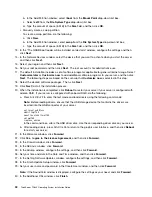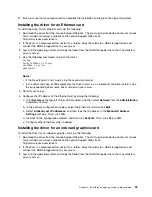
c. In the Add Partition window, select the forward slash
(/)
from the
Mount Point
drop-down list box.
d. Select
ext4
from the
File System Type
drop-down list box.
e. In the Allowable Drives window, select the hard disk drive on which you want to install the
operating system.
f. Type the amount of space (in MB) in the New Partitions Size window and then click
OK
.
• Manually create a boot partition (
/boot
in the legacy mode or
/boot/efi
in the UEFI mode)
To create a boot partition, do the following:
a. Click
Create
. The Create Storage window is displayed.
b. Select
Standard Partition
and then click
Create
.
c. In the Add Partition window, select
/boot
(or
/boot/efi
in the UEFI mode) from the
Mount Point
drop-down list box.
d. Select
ext4
(or
EFI System Partition
in the UEFI mode) from the
File System Type
drop-down
list box.
e. In the Allowable Drives window, select the hard disk drive on which you want to install the
operating system.
f. Type the amount of space (in MB) in the New Partitions Size window and then click
OK
.
• Manually create a swap partition
To create a swap partition, do the following:
a. Click
Create
. The Create Storage window is displayed.
b. Select
Standard Partition
and then click
Create
.
c. In the Add Partition window, select
swap
from the
File System Type
drop-down list box.
d. In the Allowable Drives window, select the hard disk drive on which you want to install the
operating system.
e. Type the amount of space (in MB) in the New Partitions Size window and then click
OK
.
Go back to the Partitioner window, verify that the created root partition, boot partition, or swap partition
is correct and click
Next
.
13. If the Format Warnings window is displayed, click
Format
to format the hard disk drive.
14. In the “Writing storage configuration to disk” window, click
Write changes to disk
.
15. In the “Boot loader operating system list” window, click
Next
.
16. The default installation is a basic server installation. You can customize your server by selecting a
different set of software from the software list or adding additional repositories that you want to use for
the software installation. Select
Customize now
. Then, click
Next
. The installation process begins.
Notes:
• If a warning window is displayed, select the option of your choice and then continue with the
installation.
• If you install the operating system in the UEFI mode, ensure that the
tboot-1.7.4-1.el6.x86_64 -
Performs a verified launch using Intel TXT
package is not selected.
17. After the installation is completed, click
Reboot
to restart your server.
18. The installation continues after the server restarts. In the Welcome window, click
Forward
.
19. In the License Information window, select
Yes, I agree to the License Agreement
, and then click
Forward
.
20. In the Set Up Software Updates window, select an option and click
Forward
. The following steps are
based on the scenario that
No, I prefer to register at a later time
is selected. If “Are you sure?” is
displayed, click
Register Later
.
Installing an operating system in legacy mode
41
Содержание ThinkServer TD340
Страница 1: ...ThinkServer TD340 Operating System Installation Guide ...
Страница 6: ...iv ThinkServer TD340 Operating System Installation Guide ...
Страница 8: ...2 ThinkServer TD340 Operating System Installation Guide ...
Страница 64: ...58 ThinkServer TD340 Operating System Installation Guide ...
Страница 80: ...74 ThinkServer TD340 Operating System Installation Guide ...
Страница 81: ......
Страница 82: ......






























